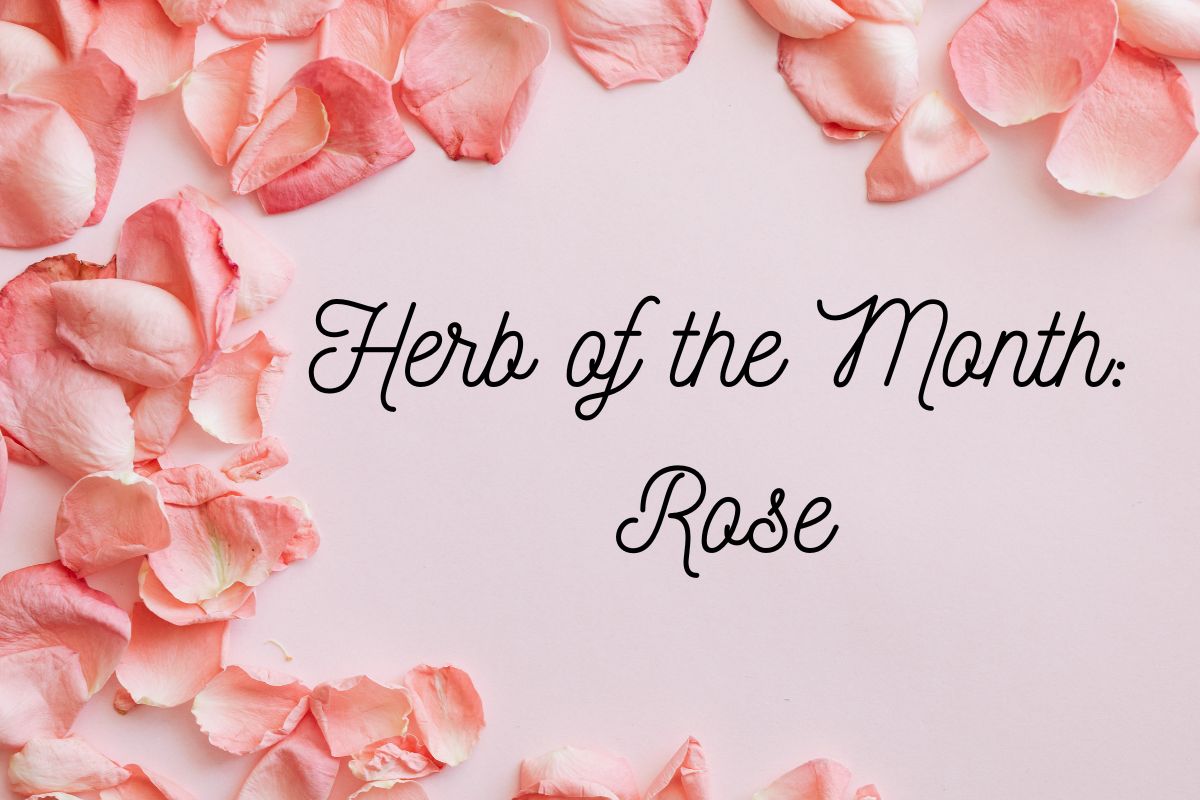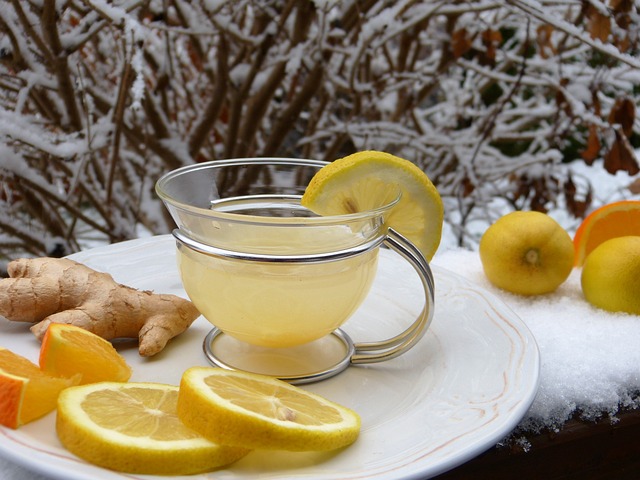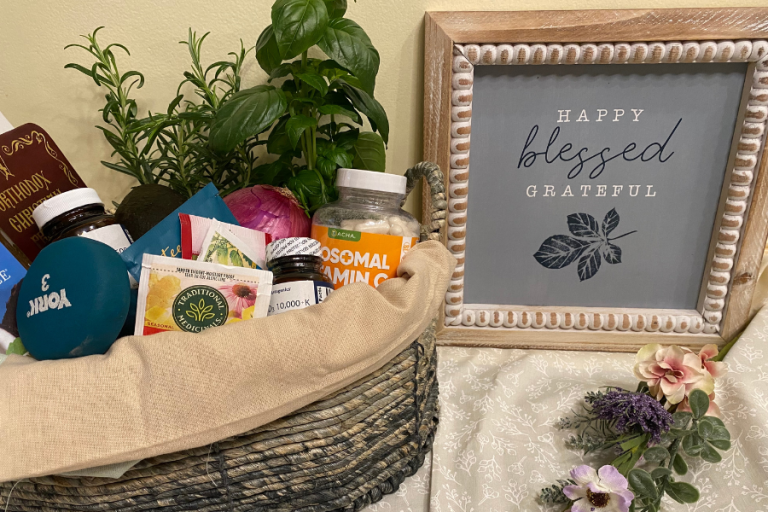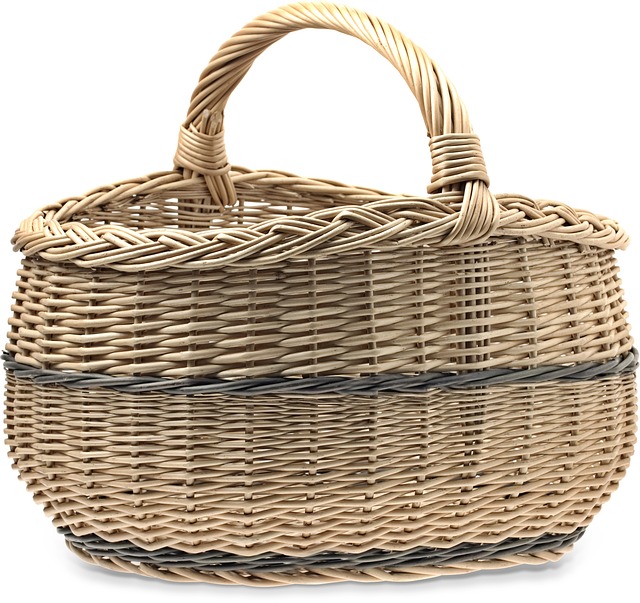July Herb of the Month : The Lovely Rose
This post may contain affiliate links. View our disclosure policy here.
My neighbor and dear friend waved to us the other day as we were walking the dog and beckoned us into her cozy kitchen. She wished us to witness the starting of her latest work of wonder- the beginnings of a new batch of Rose Meade! To anyone else it may have looked like, uh…something not all that pleasant, but to this herbalist student it looked divine! So as I contemplated this morning on what the July Herb of the month should be (while drinking my cup of green tea with tulsi and rose), it seemed pretty evident that it should be the lovely rose!
Introduction
There’s barely a need for introduction of the rose. I dare say all of my readers will have heard of it with its enormous popularity. There was certainly no lack of resources for me as I glanced at my shelf of books on herbalism- most all of them had something about rose! However, while most may only think of it on Saint Valentine’s Day or for weddings or perhaps as something to smell in the garden, there’s a whole lot more about the rose than meets the eye. And the medicinal benefits it offers are numerous.
Herb of the Month: Rose – The Basics
Family
Rosaceae
Latin Name:
Rosa canina, Rosa multiflora, Rosa rugosa
Medicinal Parts:
flowers, hips(fruits), root
Energetics:
Cool, dry, tonifying, sweet and bitter (some herbalists say bitter, some sweet, while many say both)
Actions:
The petals are antimicrobial, aromatic, astringent, exhilarant, nervine, refrigerant, vulnerary. The hips are inflammatory modulators as well as nutritive, and refrigerant. The roots are astringent and refrigerant. ***I admit I had to look up refrigerant to make sure I understood the name. With a name like refrigerant I kind o guessed and I’m sure you are to but I wanted to clarify. A refrigerant herb works by lowering your body’s temperature and cooling its tissues. And with a refrigerant herb, the effect will be much longer lasting than a dish of ice-cream will in the heat of the summer!
The Benefits of Rose
Rose is actually ideal for addressing many common ailments such as acne, anxiety, bites or stings, burns, diarrhea, high blood pressure, and more. Let’s discuss these and others in more detail.
Topical Actions
While my main focus on herbs are always “How will this tea benefit my health?”, I recognize that most herbs are helpful in many ways and rose is by far never the exception. Rose petals are wonderful for healing wounds of the skin as it is a vulnerary astringent, particularly effective with drying and healing wet, weeping wounds. A cool compress of rose tea can be used to sooth bites and stings. With its cooling energetics, rose is also superb for applying to burns and allows for faster healing. Rose water makes a lovely skin toner and is very helpful in treating acne. I love spraying rose water on my face during my morning facial routine and sometimes here and there in the day in the summer when it’s extra hot.
Protective Comforting Nervine
A nervine is a plant/herb that has an effect on the nervous system. Rose is a beautifully protective and comforting nervine. Think about it this way. In your garden or in the wild, where do the small creatures hide from the larger predators? Underneath the thorny protection of the rose bush! Rose protects your nervous system just like this- offering your nervous system shelter and a gently soothing effect. It is uplifting and can be safely worked with in conjunction with other herbs for anxiety, depression, stress relief, and issues of the emotional heart.
Cardiac Effects
In addition to assisting with emotional issues of the heart mentioned above, as a cardiac tonic rose can cool inflammation and help restore the tone of lax tissue, especially when combined with hibiscus (don’t miss out on last month’s herb!). Many heart ailments are rooted in inflammation, so working with rose hips daily with their anti-inflammatory properties can assist those ailments positively. They also have been shown to improve blood pressure and reduction of other cardiovascular risk factors.
Vitamin C
Rose hips have been worked with medicinally by many cultures throughout history. It is a plant part that is notably high in vitamin C and bioflavonoids. Choosing to make nutrient dense foods such as rose hips in your diet will increase your antioxidants and decrease oxidative stress more than any supplement can. Adding a pinch of rosehips to a cup of tea is simple and quite tasty! It’s important to note that fresh rose hips do contain more vitamin C than dried, but dried still contain lots of vitamins and other nutrients.
Nutrients
In addition to the high vitamin C content and antioxidants, rose hips are rather high in phytochemicals as well as other vitamins and minerals. This includes calcium, magnesium, potassium, beta-carotene, quercetin, tocopherols, and lycopene.
Harvesting Rose
Rose’s habitat is usually…well, just about anywhere. It does do better, though, in a sunny location with good drainage. There are a number of varieties of rose, both wild and cultivated. What I’m writing about today is the wild rose which is a simple 5 petal flower. I have not yet had the pleasure of finding wild roses to harvest but I thought I’d drop in this link to a really good blog article I found while researching more for my own post. As a Pennsylvania resident, I’m excited after just reading that wild rose CAN be found in Pennsylvania woods and are flower from June to July. I just may need to do some more hiking and exploring SOON!
Application and Practice
Rose Petals
So far I have only enjoyed dried rose petals in my tea. I have not yet found wild roses but if I did I would so love to eat them in salads or maybe even add them to ice-cream for both the psychological cooling affect of ice-cream along with the truly cooling energetics of the rose that will cool me down in the hot of summer. I’ve heard of people that candy the petals to put them on top of cakes.
Rose Hips
My favorite way to enjoy the benefits of rose hips is definitely a cup of tea. I simply take a pinch of rose hips and add them to any blend I’m making, though I really love them with hibiscus! Rose hip tea with honey and lemon makes a wonderfully soothing remedy for a sore throat. Gargling with rose petal tea can also help heal mouth sores! See more recipes below.
Rose Roots
Apparently, though I haven’t found many sources on this just yet (but who wants to dig up rose bushes?), rose roots can be rinsed, minced, and made into a nice tea. According to my guide to Pennsylvania edible plants, Native Americans used rose root tea for colds and fevers. Others say that it can be helpful as an astringent for diarrhea just as blackberry leaves are.
Rose Tea Recipes and MORE!
Rose Petal Tea
2-3 teaspoons of dried or fresh rose petals 8-10 oz. hot water honey or natural sweetener to taste (optional)
Simply place herbs into your tea infuser. Set in cup of hot water and allow to steep, covered, for 5-15 minutes according to taste and strength of medicinal benefits you seek. Add honey or natural sweetener of choice if desired.
Hibiscus Rose Tea
1 teaspoon hibiscus 1-2 teaspoons rose petals (adjust to taste) 1 teaspoon tulsi (optional) 1 pinch rose hips (optional) 8-12 oz. hot water
Simply place herbs into your tea infuser. Set in cup of hot water and allow to steep, covered, for 5-15 minutes according to taste and strength of medicinal benefits you seek. Add honey or natural sweetener of choice if desired.
Rose Bath
Fresh rose petals can easily be added to the bath along with lavender, chamomile and or oats. Bathing with herbs can be uplifting and soothing and offers a short but beneficial respite to a stressful day. If you wish to scatter the flowers loosely in the water you may want to make sure you have some mesh to cover the drain when you let the water go, or, while not as pretty, you can put the herbs in a sock or other material bag to steep in a warm bath and not make the ‘mess’. You can also make a large batch of strong rose tea and add it to the water after filling the tub. I also saw that Dr. Teal’s makes an Epsom salt mix with rose essential oil! I love Dr. Teal’s and may just have to order this if I can’t find it locally as I have not seen this particular product at the store yet.
Considerations
Remember that it is the wild rose that is preferable for working with at home for medicinal benefits. Also, rose root is extremely astringent so internal use of rose root should be approached with caution and only when necessary.

Supplies For Working With Herbs
I love to encourage others to explore herbalism, both in learning more about herbs and in making teas, tinctures and more. Here’s a few of my favorite resources. See my other Herb of the Month posts for more resources! One of these days, I’ll get around to making a nice resource page for you.
Fresh or Dried Herbs! Look in your garden or find dried herbs at Mountain Rose Herbs or The Monterey Bay Herb Company at Herbco.com (Please note I am not , at this time, affiliated with either of these companies and simply sharing for your resource information).
Some great Herbalism books to help you along your way of learning about herbs as well as guides to working with them include Herbal Medicine for Beginners by Katja Swift and Ryn Midura, This one by Rosemary Gladstar is also full of all kinds of information and recipes. I’d really like to get her beginner’s guide too. I’m not necessarily a ‘beginner’ anymore but I know it is full of lots of great information for beginners and lifelong learners alike (and everyone in between)! From what I can tell it seems to talk about growing the herbs too and I’d like to do more of that.
Tea Infusers – these are my favorite types although lately I’ve just been using this strainer sometimes too and it totally works!
General Information and products can also be found at the Earthley website! Make sure to read more about the company and why I chose to be an affiliate with them in last week’s post. Also make sure you check out their amazing selection of herbal remedies and more.
In Summary
Rose is an amazing herb to work with in addition to its natural beauty. If you are new to working with herbs, this one is easy to add to teas, baths, salads (if you have fresh petals), and more. There’s no strong cautions as it is generally safe for all.
Don’t Miss These Posts!
Have you read these herb posts? Check these out and others on My Wellness Basket!
Herb of the Month – Tulsi/Holy Basil
The Amazing Benefits of Chamomile Tea
Disclaimer – Just a little reminder here that I am NOT a medical doctor or medical professional of any kind. I’m simply a Christian woman who loves exploring herbalism and other areas of achieving optimal health in a holistic approach. I also love writing and sharing with others all the things I am learning! Be sure to continue reading posts here and also explore a variety of other resources to further your education and knowledge! And always try to apply what you learn as you travel your own wellness journey! See my disclaimer page.








Thank you for shedding light on the incredible medicinal uses of roses. I have always admired these delicate flowers for their beauty and fragrance, but I had no idea about all their healing properties until I read this blog post.
I’m so glad you had a chance to learn something new about them today. Hopefully you will try them soon. Even your local grocery store may have some sort of tea blend with rose. If not, a quick search on Amazon, Thrive Market, or Mountain Rose Herbs will help!